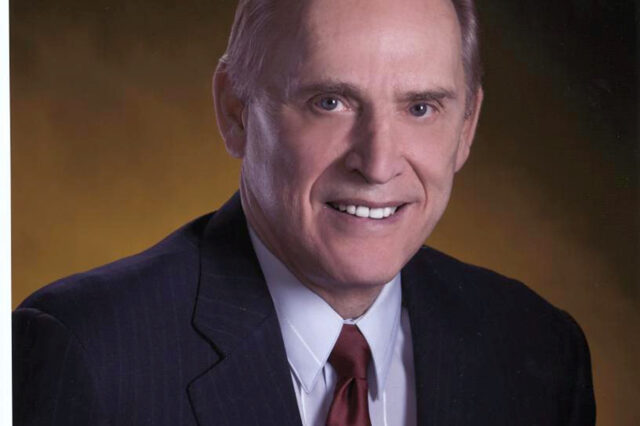UF mourns passing of physician who pioneered field of interventional radiology

Irvin Franklin “Dick” Hawkins, M.D., a professor of radiology and surgery at UF for more than 50 years
One of the University of Florida’s most esteemed physicians, Irvin Franklin “Dick” Hawkins, M.D., a professor of radiology and surgery at UF for nearly 50 years, passed away Wednesday, June 8. He was 74.
“Dr. Hawkins will be missed greatly at the University of Florida,” said Michael L. Good, M.D., dean of the College of Medicine. “Through his commitment to improving patient safety and comfort, he brought international acclaim to the College of Medicine.”
Dr. Hawkins was recognized throughout the world as a pioneer in interventional radiology and had a profound impact on the field. He received numerous awards for his work developing many of the minimally invasive radiological and cardiovascular procedures that are used today. But more important than the awards, Dr. Hawkins’ legacy will be the many improvements he made in patient safety and comfort, Good said.
He may be best known for pioneering the use of carbon dioxide as a contrast agent for imaging a patient’s cardiovascular system. CO2 angiography is widely used today and in fact is gaining popularity due to cost concerns and the nephrotoxic effects of other contrast imaging agents. He also is recognized for his groundbreaking work in needle and catheter design — proving that reduction in catheter size reduced complication rates as well as made every anatomic location in the body accessible to minimally invasive techniques. Because of this advance, fields such as interventional cardiology and interventional neuroradiology have flourished and have helped millions of patients throughout the world.
“We have lost an irreplaceable creative genius,” said Anthony Mancuso, M.D., chairman of the department of radiology. “But his legacy of innovative and improved patient care will be preserved and grow from those he has trained and inspired.”
Other innovations from Dr. Hawkins include the development of the blunt needle system, which greatly reduces the risk of bleeding; co-axial needle guide systems, which improve the ability to reach specific locations in the body; the accordion drainage system; the micro-needle TIPS set; and the specialized needle for breast mass localization. Dr. Hawkins was the first physician in the world to safely perform a percutaneous cholecystostomy more than 30 years ago. All of these innovations are still widely used today and firmly established in the use of core interventional radiology procedures.
Dr. Hawkins’ crowning achievements came when he received the very first Innovators Award in 2002 from the International Symposium of Endovascular Therapy as well as the first Leaders in Innovation Award in 2003 from the Society of Interventional Radiology. He also received the Silver Award from the American Roentgen Ray Society in 1983 for CO2 angiography and digital subtraction radiology. The Association of University Radiologists named him Grand Champion of Exhibits in 1983 for the retrograde transcutaneous nephrostomy technique, and he won the prestigious Gold Medal from the American Roentgen Ray Society in 1984. He is the original author of hundreds of peer-reviewed journal papers and of numerous textbooks. He also authored or co-authored countless book chapters.
In addition to his pioneering role in the field of interventional radiology, Dr. Hawkins was also an excellent teacher and mentor, who taught his students not only the fundamentals of his field but also his approach to medical innovation, stressing open-minded and creative thinking. As a result of his dedication to teaching, many residents and fellows have been inspired to follow in his footsteps and improve patient care and comfort.
Dr. Hawkins was born in Baltimore in 1936. He received a bachelor of science degree in 1958 and a medical degree in 1962 from the University of Maryland. He then completed an internship at Mercy Hospital in San Diego and was a captain in the U.S. Air Force from 1963 to 1965. He completed his residency in diagnostic radiology at the Ohio State University. Dr. Hawkins began his career at the UF College of Medicine in 1968 as the National Institutes of Health fellow and special trainee in cardiovascular radiology.He became chief of interventional radiology in 1969, a position he held for the next 30 years. He advanced to professor of radiology in 1976, as well as professor of surgery in 1981. He was board-certified by the American Board of Radiology in 1969 and was a member of numerous local, national and international societies.
As a professor emeritus at UF, Dr. Hawkins remained actively involved with the department of radiology, hosting monthly journal clubs, interventional clubs and case review sessions at his home on Lake Wauburg.
Dr. Hawkins is survived by his wife, Kitty; his sister; three children and 11 grandchildren. While his passion in life was innovating medical devices and new techniques to improve the lives of his patients, he also enjoyed many extracurricular activities. He was a former nationally ranked water skier and continued to ski throughout his life. Other hobbies included traveling, scuba diving, playing the piano, singing and playing racquetball with his friends.
“While his death came too soon, we can take comfort in knowing that he lived life every day doing exactly what he loved doing, surrounded by family and his friends,” said Scott W. Peterson, M.D., an assistant professor in the division of vascular and interventional radiology.